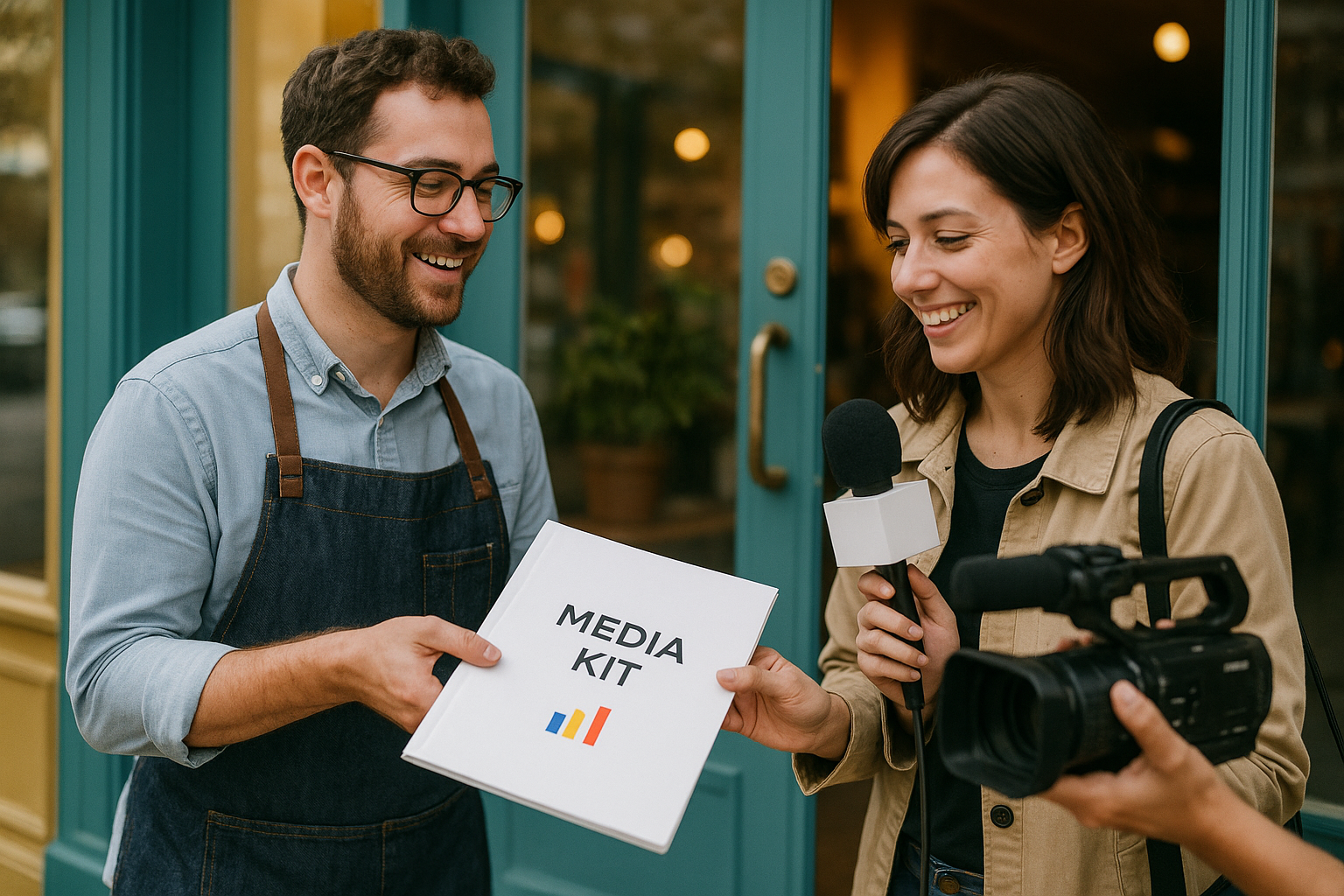You want local news to talk about you without paying for ads. Smart. Local press builds real trust, sends referral traffic that converts, and powers your local SEO. This playbook shows how to think like a scrappy publicist without turning into a spam cannon. You will map out angles that reporters actually use, pull together a media kit in an afternoon, pitch with personality, then turn every mention into backlinks, E E A T signals, and Google Business Profile gains. Grab coffee. We are going to make your business newsworthy enough that the weather guy learns your name.
Why local news beats ads
Local news coverage gives you authority that an ad can never touch. People believe stories told by a journalist far more than a banner that shouts buy now. Mentions on a city paper or radio site often come with a live link to your site. That link is gold for local search because it is both relevant and trusted. If you want a deeper breakdown on the SEO lift you get from coverage, read our guide on how backlinks boost local SEO. Short version. News mentions create hyper local signals that help your Google rankings for service terms in your town. Those links also send qualified visitors who read about you first then click with intent.
There is a second upside. Google cares about real world proof that a business knows its craft and serves real people. That is the heart of Google E E A T guidance. Outside recognition from local media, paired with named experts and sources, checks those boxes. Thoughtful coverage can outrank a stack of generic blog posts because it proves you exist, you help your community, and you have experience worth spotlighting.
Find angles reporters will use
Reporters chase relevance. Give them something timely, local, and full of real people. You do not need a dramatic product launch. You need a reason a neighbor would care enough to read to the end. Think in angles, not features. Tie your work to a community need, a timely data point, a seasonal moment, or a person with a face and a quote. The more local the hook, the better your odds.
Community and sponsorship hooks
Nothing beats a story that shows your business doing tangible good on the ground. Sponsor a youth team. Host a free workshop. Run a donation drive. Make it public and helpful. Then invite media with a clear why this matters to our town. We have a full playbook on local sponsorships and press coverage if you want tactics that turn neighborhood goodwill into headlines. If you want an event that earns cameras and cameras earn clicks, use our guide on how to host local events that attract press.
Practical idea. A home service company can run a free safety check day before winter. A dentist can offer school mouthguard fittings before fall sports. A pet store can partner with a shelter for an adoption weekend. Each idea serves a need. Each idea has photos. Each idea gives a reporter a feel good story with a helpful angle.
Data, trends, and customer stories
Journalists love clean data that shows a local trend with real stakes. They also love short, personal stories with a willing source. Keep pitches tight, local, and backed by a quote or numbers. Cision and Muck Rack both stress that short and relevant wins, with data and multimedia as multipliers. Read their how journalists want to be pitched guide and Muck Rack on pitching best practices for journalists before you email a soul.
Create simple datasets from your own bookings or calls. You might see a spike in emergency roof repairs after storms in one ZIP code. You might see a rise in water heater calls for a certain brand. You might have survey results from your customers on a timely issue. Keep it local. Offer the numbers, the cause, and a named expert to explain what it means for neighbors.
Human stories are equally strong. Highlight a customer who reached a positive result, with permission and photos. Avoid anything exploitative. Reporters want to show people, not just products. Make the person the focus, and your role becomes part of the story, not the whole thing.
Timeliness and tie ins
Watch school calendars, city council agendas, seasonal shifts, and crime or safety alerts. Tie your pitch to what the newsroom already covers this week. A contractor can brief a reporter on post storm repair scams with a homeowner quote. A restaurant can share a food safety angle during a heat wave. A financial advisor can explain new local tax credit changes with a simple guide. When you match the beat and the moment, your pitch feels like help, not a sales plea.
Build a media kit journalists like
Reporters work on tight deadlines. Give them everything they need in one place. A simple media kit on a public page of your site saves back and forth, makes you look ready, and lowers friction. Use this checklist adapted from the Cision media kit checklist with a Rep Lock spin so you can finish it today.
- One page press summary. Fifty to seventy five words that say what you do, who you serve, and why your work matters locally.
- Topline facts. Founding year, owner names, headcount, service area, hours, full N A P, and one meaningful metric like customers served this year.
- Short bios. Name, title, one or two lines of relevant credentials, plus a direct media contact with email and phone.
- Images. Two or three high resolution brand images. A transparent logo in PNG and a JPG hero shot. Add suggested captions and any photo credit.
- Spokespeople. Who can talk, what topics they can cover, and typical availability windows so producers can plan interviews.
- News hooks. One to three story ideas with a local angle, plus suggested sources such as a customer or partner with a short line on what they can speak to.
- Prior press. Links to any past mentions to show credibility.
- Downloads. Logo files in PNG and SVG, press headshots at print quality, a short social ready video if available.
Post this on a page called Press or News in your main navigation. Add direct links to this page in your pitch emails. Include image files named in plain English for accessibility. For better image SEO, follow our guide on image and alt text best practices. Clean file names and descriptive alt text reduce friction for newsrooms and help your own rankings.
Pitch local journalists the right way
Pitching is a craft. Keep it short. Make it personal. Lead with the local angle. Offer data or a source. Then stop typing. Do not B C C half the city. That is how you get blocked or roasted on Twitter. You are writing to a human with a job to do. Help them do it faster.
Subject line and format
Use your town name at the start of the subject line. Keep it under eight words. Offer an exclusive if you truly have one. Mention that images are ready if you have them. In the body, write one clean hook line and then two or three short lines with the key facts and the next step. Close with your media kit link and your phone number. That is it.
Three short templates
Template A. News hook with a local angle
Subject. Springfield small business offers free after school program
Hi Jane, I read your recent story on youth activities in Springfield. We are launching a free after school program at our shop on May 12 for up to 40 families. I can connect you with the owner, Carlos Rivera, a former teacher, plus a parent who will speak on record. Key points. what it is, who it serves, why it matters locally. Would you like an exclusive or more details. Thank you, Sam at 555 123 4567. Press info at yoursite dot com. Media kit link
Template B. Data trend with an expert source
Subject. Local trend. Roof repair requests up 32 percent in Mason County
Hi Mark, our service data shows a 32 percent rise in emergency roof repair requests in Mason County in Q2. I can share the dataset and connect you with our owner, Dana Lee, who can explain local causes and show photos from two neighborhoods. Quick hits. the stat, the impact, availability for an interview this week. Interested. Sam at 555 123 4567. Media kit link
Template C. Human interest customer story
Subject. Client in Riverton recovered fast after basement flood
Hi Maya, pitching a local human interest story. Our client, Lila, used our restoration team after a basement flood last month. She is open to an interview and is fine sharing two photos. Can I send a short Q and A and images. Thank you, Sam. Media kit link
Follow up cadence that respects inboxes
Wait two to three days. Send one polite follow up. Then stop. Many reporters say one follow up is plenty. You will find this echoed in Muck Rack pitching best practices for journalists and PRSA on what reporters want from PR pitches. If you hear crickets, your angle might not fit this week. Save that person for a better moment, or pitch a different contact with a stronger tie to your story.
Turn coverage into SEO wins
Press is not just ego fuel. It should drive rankings, traffic, and calls. That requires a few simple steps right after your story goes live. Treat each mention like an asset to publish, link, and repurpose across your ecosystem. If you get a TV segment, ask for the online version. If you only get print, ask the editor if they can post the story to their site so readers can find it on search. Make it easy to say yes with ready quotes and images.
Ask for links and correct N A P
When a piece runs, thank the reporter with a short note. Politely ask if they can include a link to a relevant page on your site, such as your press page or a blog post with more detail. Offer the exact URL and your correct Name Address Phone so their listing matches your citations. This helps Google match the mention to your entity. For a deeper view of link value from news, read how backlinks boost local SEO again and steal a tactic or two.
Use Google Business Profile
Post the coverage on your Business Profile with a short description and a photo. Google highlights posts for events and updates, which keeps the news visible on Search and Maps. Guidelines live at Google Business Profile posts. Add a line like As seen in Springfield Gazette with the link. Then add a photo from the event or the interview. Track views and actions in your Profile Insights.
Repurpose across your site and social
Create a Press or News page that lists each mention with a one line summary and a link. This centralizes coverage for visitors and search engines. Post a short recap on your blog that quotes key lines from the article and adds a behind the scenes detail. Link from the recap to your service pages. If the coverage started from an event, use our guide to host local events that attract press and write an event recap that you can pitch again next season. Finally, update your site so new visitors have a clear call to action. If you expect traffic after press, make sure your phone number is hard to miss and your forms are short. This post will help you improve conversions after press coverage.
Add E E A T signals on site
Match your press with on site trust cues. Add author bylines with short bios on content. Add a simple About page that names the owner and team with real credentials. Include selected press logos on your homepage. Link each logo to the coverage when terms allow. These steps line up with Google E E A T guidance and give algorithms more confidence that your business is a real authority in your niche and city.
GBP and N A P for local lift
Small N A P mistakes can waste the SEO benefit of a great story. Your Name Address Phone should match across your website, GBP, and citations. After coverage, double check that the outlet listed your N A P correctly. If they missed a suite number or wrote North instead of N, ask for a correction. Then bring that same care to your own listings. Our guide on local SEO basics NAP and GBP lays out the basics for maintaining those signals so your mentions pull more weight in local search.
Use GBP posts for each new mention, plus event and offer types when relevant. Add new photos from the press day. Reply to reviews that mention your coverage. People will tell you they found you in the paper. Thank them, then ask what question the article answered for them. Use that insight for your next pitch. Keep your categories, hours, and services up to date so press driven visitors see accurate info when they click from the article to Maps.
Images and alt text that help you rank
Journalists love when you hand them ready images with clear captions. Your own SEO likes it too. Use descriptive file names and write alt text that explains the image plainly for screen readers. Avoid stuffing keywords. Focus on what the image shows, who is in it, and where it happened. For step by step image tips, see our primer on image and alt text best practices.
Three quick examples you can borrow for alt text. Local business BrightSide Electric sponsoring River Run 5K in Dayton with banner and volunteers. Tara Gomez owner of BrightSide Electric standing in front of the company van. Before and after kitchen countertop replacement for Sheila in Oakwood. Those lines serve accessibility first and give search context without fluff.
Reporter query services
You do not have to pitch alone. Sign up for reporter query services where journalists post source requests. These can lead to quick wins and credible links, especially for expert quotes. Services change over time so always check current sign up and rules. Start with reporter query services HARO and the directory at O N A. Respond fast, write short, and only answer what you are qualified to answer. Do not pitch off topic. Editors have long memories.
Track what moves the needle
Press that does not turn into growth is just a nice ego boost. Track what matters so you can pick the winning angles and double down. Start simple. Keep a sheet with columns for outlet, date, link, and the main angle. Add performance fields and update them weekly for a month after each mention. You will spot patterns fast.
Metrics to watch. Coverage volume and the reach of each outlet as a directional indicator. New backlinks and referring domains in Search Console or your favorite tool. Referral traffic to your site from the outlet with bounce rate and time on page. Conversions from that traffic, such as calls or form fills. GBP metrics that spike after press, such as searches, views, calls, or direction requests. Pitch performance such as open rate and replies if you use email tracking. You do not need a PhD. Look for which angle delivered coverage, links, and leads. Repeat that theme, retire what fell flat.
Mistakes that kill your pitch
I love a bold pitch. I do not love inbox crimes. Avoid these if you want any reporter to open your next email without side eye. Do not mass blast with a generic message that ignores the beat. Do not write a three page essay with no local angle. Do not pitch without images, data, or a human who will talk on record. Do not send your pitch from a no reply inbox. Do not forget to ask for a link after coverage goes live. Do not skip your GBP update or your site Press page then wonder why the SEO lift is missing. Want proof. Cision and Muck Rack repeat these warnings in their how journalists want to be pitched breakdown and pitching best practices for journalists guide. I did not make this up. Your local editor complains about it on social every week.
Quick checklist you can use today
- Pick three local story angles tied to community needs
- Publish a one page media kit with images and a contact
- Create two short pitch versions. news plus data or human interest
- Collect three high quality photos and a short bio for a spokesperson
- Pitch five targeted journalists with personalized notes
- Follow up one time after two or three days
- Track coverage, request a link, and post to GBP
- Publish a Press page and share the mention on social
FAQs
How do I find the right journalists
Start with your local paper, TV stations, radio shows, and neighborhood blogs. Read bylines and make a list. Note who covers your beat such as business, city, schools, or lifestyle. Search Twitter and LinkedIn for reporters in your town. Build a list of ten contacts with names, recent articles, and emails. Avoid generic inboxes when possible. Pitches sent to a person beat pitches sent to info at outlet dot com.
What if I have zero past press
No problem. Start with a story that serves the community. Launch a helpful event or publish a local dataset. Offer an exclusive to one outlet. Make it easy for them to say yes with a real person to interview and clean images. Once you have one mention, add it to your site and pitch the next idea, now with proof that you make news.
How long should a pitch be
Think four to six sentences max. A subject line with your town, one hook line, two or three lines with the essentials, a clear ask, plus your media kit link and phone. That is it. If they want more, they will reply. If you send a wall of text, they will not.
What if my angle is seasonal
Great. Pitch early. Newsrooms plan seasonal content ahead of time. For back to school, pitch in late July. For winter prep, pitch in early fall. For tax topics, pitch in late winter. If your idea ties to a city event or council vote, pitch as soon as the agenda hits the calendar.
Do I need a press release
Only if you have a formal announcement such as a new location or a large partnership. For most local stories, a tight email pitch with a data point or a human source works better than a long release. If you do write one, keep it on a web page with a link in your email. Avoid attachments that get caught in filters.
How do I handle a live interview
Pick one key point and one short story that supports it. Practice the sound bite out loud. Keep it audience first. Think about what would help a neighbor act or decide. Speak in simple words. No jargon. Bring one stat and one example. Finish with a clear next step for viewers or readers.
How do I get more links from coverage
Offer a useful resource on your site that extends the story. If the article covers winter safety, publish a short checklist with photos and ask the editor to link it. If you ran an event, publish a recap with quotes and a gallery. Ask politely for a link to that page. Follow up with a thank you either way. You will be surprised how often a friendly, specific request lands a link edit.
What should I do on my site after press hits
Feature the story on your homepage for a week. Add the logo to a Seen In row and link to the article. Publish a short blog recap with added context. Link that recap to relevant service pages. Update your GBP with a post that includes a photo and the link. Then post on social and tag the outlet and the reporter. This keeps the momentum going while signaling trust across your channels.
Putting it all together
Local press rewards businesses that act like neighbors first and marketers second. Give your town something useful. Pitch short and relevant with data and faces. Make life easy for the newsroom with a clean media kit. When the story lands, turn it into links, GBP visibility, and conversions. If you want more structure around setup and follow through, our posts on local sponsorships and press coverage, how backlinks boost local SEO, local SEO basics NAP and GBP, and image and alt text best practices will keep you busy in the best way. Now go pitch something your city actually wants to read, then call me when the phones start ringing so we can make sure those visitors turn into customers.






